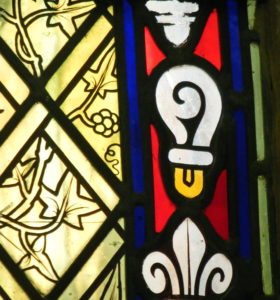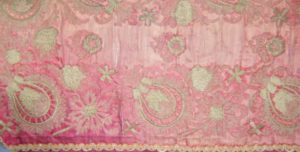 We know that light can damage some objects. How serious is it? And what can we do to protect our collections?
We know that light can damage some objects. How serious is it? And what can we do to protect our collections?
In this resource we will look at:
- Why light and UV radiation are damaging
- What objects are at risk
- How to measure light exposure
- How we can protect objects from light and UV radiation
What is the problem?
Visible light provides energy which enables chemical reactions to take place. Ultraviolet radiation has a shorter wavelength and provides even more intense energy. Some materials of which objects are made are very sensitive, especially organic materials such as textiles, fur and feather, leather and hide, bone and ivory and plastics. Some inorganic minerals and pigments can also be sensitive. Dyes, including those in watercolour paints, and photographic media are also highly sensitive.

Image 1. Textile faded and structurally damaged by light
The damage can be visible within a few hours of exposure, but it’s important to remember the damage is structural, not just cosmetic, and cannot be undone. Textiles may fade, but they also become more brittle (see Image 1). Plastics may yellow, but their structure will also cross-link causing them to shrink and crack. Light and UV also damage display materials, furniture and fittings in the museum.
Inorganic materials like ceramics, glass and stone tend to be less sensitive to light but can be affected by heat, especially infra-red radiation which can be emitted by lights as well. We know how hot direct sunlight is.
How do we measure it?
Light is measured in lux. 1 lux is equivalent to the light of 1 candle over 1 square metre of surface. UV radiation is measured in μW/lumen (microwatts per lumen).
People used to say that 50 lux was a suitable light level for sensitive objects, but this was based on the minimum level at which the average human eye can detect colour accurately and did not consider the amount of time an object is exposed. Light damage is cumulative – each moment of exposure makes the damage worse.
Nowadays the guidance is that light sensitive objects should not be exposed to more than 150,000 lux-hours per year and less sensitive ones should not receive more than 300,000 lux-hours per year. Very sensitive objects should receive much lower exposures.
We can measure light intensity using a light meter or a suitable app such as Light Meter by My Mobile Tools Dev on a smartphone (this one has been tested and is reasonably accurate). Hold the meter close to the object and make sure that nothing is in the way of the light falling on the sensor (or front camera of a smartphone). Multiply the lux by the number of hours a year an object is exposed to the light. The result is the annual exposure, e.g. 150 lux for 6 hours a day for 200 days = 150 x 6 x 200 = 180,000 lux-hours p.a.
Objects should not be exposed to any ultraviolet radiation at all. A few minerals fluoresce in UV light and special display units can be created for them.
UV can be measured using a special meter. You can arrange to borrow one from the Conservation Development Officer (CDO).

Image 2. Card for measuring light damage
How do we monitor light damage?
It’s really hard to see how objects are changing colour unless we compare them to an accurate photo or look at the difference between an exposed and unexposed area. However we can create light-fade cards that show us the difference more easily (see Image 2). The textile industry monitors lightfastness by comparing a product with specially dyed blue wool fabrics that fade at a known rate. The three most sensitive Blue Wool fabrics fade at about the same rate as photographs, textiles, fur and feather. We put a small strip of each of these fabrics on a card with a cutout frame. When the card is closed part of the strip is protected. When we open the card we can easily compare the exposed and unexposed areas to see how much fading has taken place.
We supply these cards to museums in the Southwest through the Central Purchasing Scheme offered by the SWMD through the Conservation Development Officer (CDO).
We can also get some idea of the light-exposure by measuring the difference between the two areas using a spectrophotometer. Please contact the CDO if you want to know more about this.
What can we do about it?
- Keep UV below 10 μW/lumen by using UV filter film on windows and replacing older lights with LED bulbs
- Never allow direct sunlight on an object
- Keep objects in darkness whenever possible, to prevent unnecessary damage
- Keep the annual light exposure below 150,000 lux-hours p.a. for sensitive objects.
- The UK has 4535 hours of daylight p.a. If a light-sensitive object is exposed to daylight, the MAXIMUM lux that should be allowed is 150,000 divided by 4535 hours = 33 lux, which is too dark to see it clearly. We have to reduce the length of exposure.
- Use blinds, screens or covers to protect objects from daylight, especially when the museum is closed.
- Think about the distance between the object and the light source. Intensity drops dramatically when the light is further away.
- Use PIR switches or visitor-controlled buttons to allow objects to be lit only when being looked at.
- Offer visitors torches to discover objects in dimly lit areas.
- Use boxes and covers to protect stored objects. Keep drawers and cupboards closed.
- Do not display light sensitive objects permanently. Use replicas or rotate objects.
- Different parts of an object may have different reactions – always think about the most vulnerable material.
- Flash photography is unlikely to cause significant light damage. Photographic lights left on for long periods will.
Top Tips
- Light (and UV) damage is cumulative and irreversible
- No object should be in direct sunlight
- Objects should be protected from light damage when the museum is closed.
- Light sensitive objects should not be on permanent display
